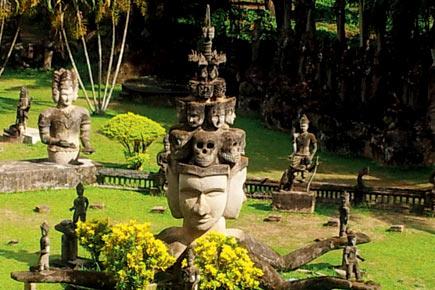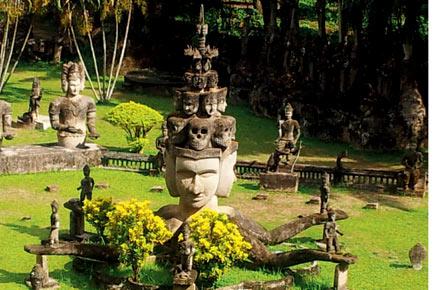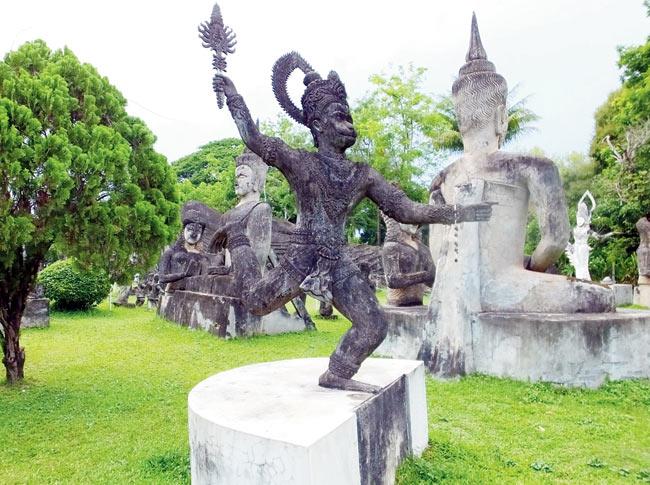A lesser-known fact in Laos, in South East Asia, is the fascinating confluence of Hindu and Buddhist elements that dot its landscape. the guide looked closer from ground zero

Buddha Park
A languid paced destination, dotted with long lunches, afternoon naps on hammocks, and evenings spent watching the sunset by the beautiful Mekong riverside. The imagery is inviting. Laos that opened up to tourism in 1989, remains a lesser trod, and hence a mystery to most travellers. One of the least urbanised nations in this part of the world, it offers an old-fashioned charm, complete with French villas, and golden spires of Buddhist temples.
ADVERTISEMENT

An aerial view of the Buddha Park in Laos. Pic CourtesySY/Urmi Popat
Hinduism meets Buddhism
Unlike its neighbour Vietnam, Laos was influenced by Indian culture rather than Chinese. From 1AD, Indian merchants introduced Theravada Buddhism to Laos. From the 9th to the 13th century AD, the Khmers from neighbouring Cambodia ruled much of what is now Laos. Hinduism was one of Khmer Empire’s official religions, and examples of Hindu themes can be found on the Laotian temples from that era.

The nearly 40m-high reclining Buddha statue is a huge draw inside the park. PICS COURTESY/URMI POPAT
The Laotian adaptation of the Ramayana is called Phra Lak Phra Ram. Experts share that Phra Lak (Lakshman) comes first in deference to his voluntary assistance of Phra Ram (Ram). The importance of Phra Lak Phra Ram can be seen in dances, dramas, songs, paintings, and more.

Hindu gods like Hanuman are a common sight at Buddha Park
induism blended easily into Buddhism, so many Hindu gods are considered Thaen. Interestingly, Buddhists monks have incorporated much of Brahmanic rituals, including the reverence for Nagas (snake-like demigods that rule the waterways). One can spot stairs to many temples and shrines being guarded by Naga snakes. Apparently, Thailand, Laos and Cambodia are part of the Indo sphere — the zone of Indian cultural influence, although Hinduism does not overtly influence Laotians as their neighbours in Thailand.

This pumpkin-like structure is the ideal spot to view the entire Buddha Park
The Pondicherry connect
In 1868, Laos became a part of the French empire in South East Asia. In the early 20th century, when Pondicherry was also under French rule, many Tamil-speaking Muslims from the area migrated to Vientiane, the capital of Laos and worked mainly as guards and labourers. Currently, most of them (approximately 200) deal in cosmetic trading while the rest run Indian restaurants.
Buddha in stone
The Pha That Luang or Great Stupa is the most important Buddhist monument in Laos. Local legend goes that monks sent out by the Indian emperor Ashoka to spread Buddhism arrived in Vientiane in the 3BC. A stupa was erected here to enshrine a breastbone of the Buddha. In the 12th century (AD), the Khmer built a temple here, remains of which have been found. The large ground surrounding the gleaming golden stupa (which was rebuilt by the French after heavy damage) has many gilded statues of Buddha and Hindu deities like Shiva.
Xieng Khuan or Buddha Park is a famous sculpture park on the outskirts of Vientiane, with over 200 religious statues including an approximately 40m-high reclining Buddha. A monk who claimed to have been a disciple of a Hindu holy man built it in 1958. As you stroll in this garden of wonderful concrete monoliths, you will be awestruck by statues of Hindu gods including Indra, Shiva, Vishnu, Krishna, Arjun and Hanuman as well as demons and animals from both beliefs.
The best spot for photography here is atop a giant pumpkin-like structure. The entrance to this dimly-lit structure is from a demon’s mouth, having an internal narrow stone ladder leading to a level below (representing hell) and a level above (representing heaven). As you reach the top and come out of a narrow opening, lo and behold — you catch a breathtaking bird’s eye view of the entire park!
Laos has been attracting not only culture vultures, but the unspoiled mountainous geography of the country is putting it on the world map as a destination for thrill seekers in search of the wilderness, backpacking or simply those who wish to rejuvenate in this serene landscape.
 Subscribe today by clicking the link and stay updated with the latest news!" Click here!
Subscribe today by clicking the link and stay updated with the latest news!" Click here!






